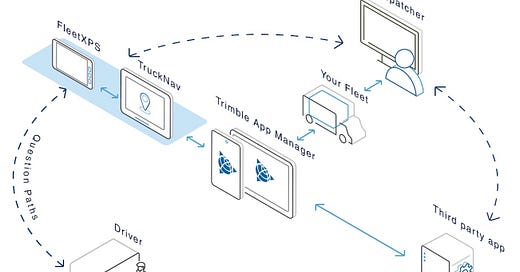Enterprise Driver Workflows: Insights, Case Studies & Lessons Learned
Boost efficiency, safety, and satisfaction
Enterprise Driver Workflows: Insights, Case Studies & Lessons Learned
Bottom line: optimizing driver workflows is a competitive necessity, evolved from checklists to dynamic, intelligent systems. From logistics to field services, enterprises are reimagining how drivers interact with systems, data, and each other to boost efficiency, safety, and satisfaction. Let’s explore enterprise implementation.
Personal note from author: One of my contacts, Dave, is a motor coach operator, so he shared some points of consideration regarding his driver workflow and communications with dispatch. Also, a relative once operated a rig for long haul, so I had some elements of consideration from his stories. While driver logs may indicate on-time arrivals or departures, in-cabin monitoring and compliance may find patterns of behavior that tell the full story of driver patterns, whether high-risk in terms of safety practices, aggressive driving, or idling, etc. -Marky
🔍 Insight: Intelligent Workflows Reduce Friction and Boost Productivity
AI workflows are used to eliminate manual bottlenecks and empower drivers with support while on the road.
📘 Case Study: IBM’s Virtual Enterprise Transformation
IBM reengineered its internal workflows—including lead-to-cash and supply chain processes—using AI, hybrid cloud, and automation. The result?
4 million work hours saved
20-point boost in employee engagement
$2.6 billion in business value generated
Drivers and field agents now use AI assistants to streamline tasks like billing, routing, and compliance reporting, freeing them to focus on higher-value work.
What worked:
Agile implementation via the IBM Garage™ framework
Cross-functional collaboration and user-centered design
Embedded AI for real-time decision support
What didn’t work well:
Initial complexity in aligning siloed systems
Resistance from teams unfamiliar with agile methods
📅 IBM Intelligent Workflows Case Study
Insight: Standardized Platforms Enable Scalable, Secure Driver Operations
Enterprises that adopt platform engineering principles can unify fragmented driver workflows, reduce costs, and improve compliance.
📘 Case Study: Insurance Company’s Platform Engineering Overhaul
A large insurance firm faced rising cloud costs and inconsistent driver onboarding processes. By implementing a standardized platform using tools like GitHub, OpenShift, and Backstage, the results were noted as:
Reduced provisioning time
Improved governance and compliance
Enabled self-service for driver-related tasks
What worked:
Build-operate-transfer (BOT) model with external partners
Centralized governance with flexible developer access
Adoption of open-source tools for cost-effectiveness
What didn’t work well:
Developer resistance to new platforms
Legacy measurement systems misaligned with business KPIs
📅 Microsoft Platform Engineering Case Studies
Key Success Factors for Enterprise Implementation
Across both cases, several success factors stood out: (though one could argue that these are simply elements of coordinating program management, and do not address the how, the methods of implementation in contrast to organizational challenges and impediments to allocation of resources)
OKR: Whether it’s reducing costs or improving safety, clarity drives alignment on intended outcomes.
Change management: Early engagement with drivers and managers is critical to adoption. (What about incentives? The narrative theme of why.)
Integrated tech stack: integration with systems prevents workflow fragmentation.
Cause & effect loops: analytics help refine workflows continuously.
🚧 Lessons Learned: What to Avoid
Siloed implementation: Without cross-functional buy-in, workflows remain fragmented.
Overengineering: Complex solutions without user input often fail to gain traction.
Neglecting user experience: Drivers need intuitive, mobile dashboard tools - not just backend automation.
Summary: Enterprise driver workflows moved from checklists to dynamic, intelligent systems. The organizations that succeed are those that treat workflow transformation as both a technical upgrade and a cultural shift. Draft the narrative - agility, safety, and satisfaction for the driver workforce.
If checklists were long praised for safety & efficiency across industries, the distinction here in my view is linking multiple checklists dynamically based on changes in inputs for operational problems, abnormalties, contingency and backup. This should place the driver and operator’s effort on the momentum for problem-resolution, rather than the problem itself. -Marky







